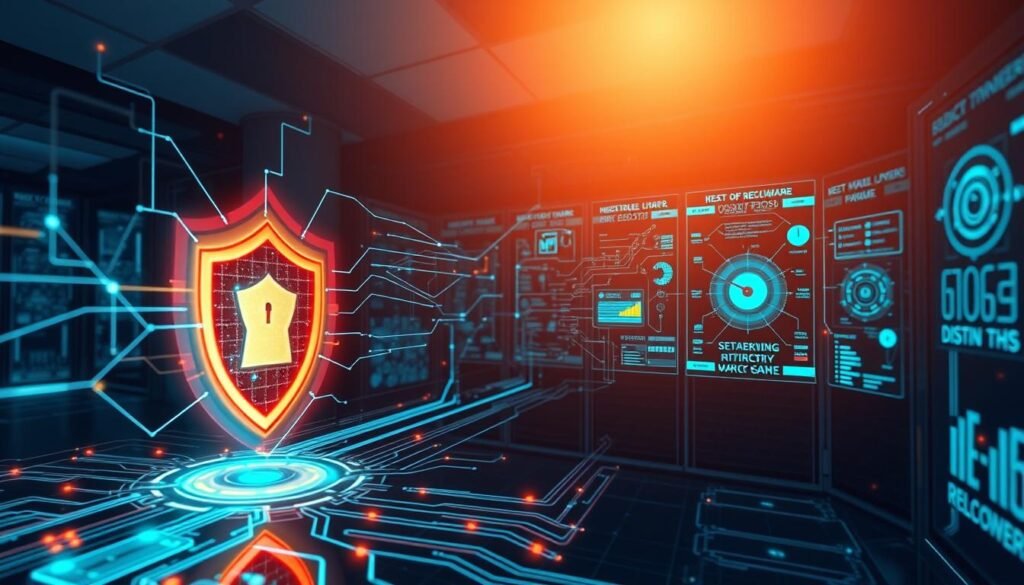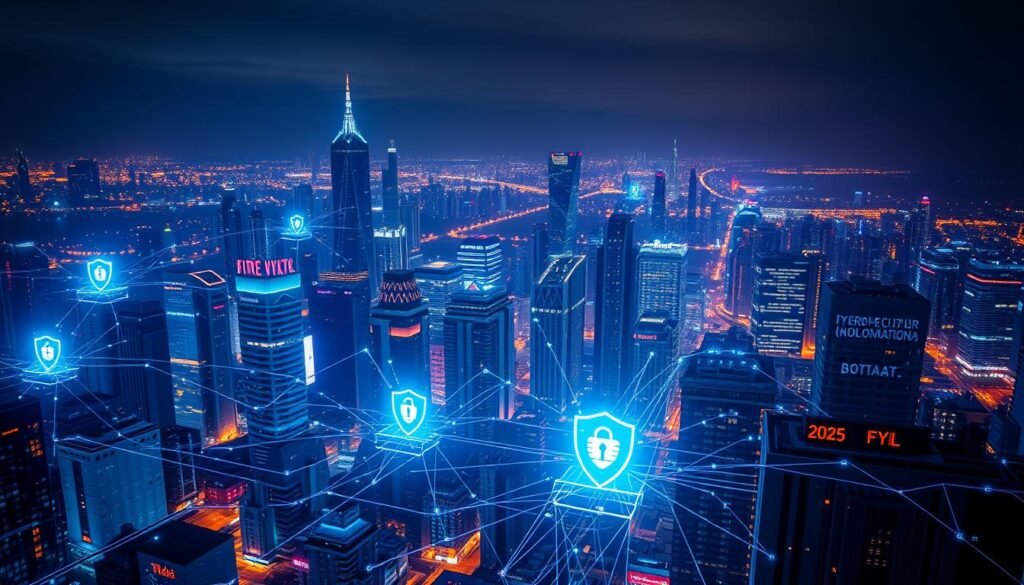In the last year, 83% of companies faced a ransomware attack. The average demand was over USD 5.2 million. This shows how fast and complex the world of cybersecurity is. It’s key to know the current state and future trends in 2025.
This includes how threats evolve, the role of AI, and the need for strong network security. We must protect against advanced malware, ransomware, and data breaches.
To fight these threats, you need a proactive cybersecurity plan. Focus on detecting threats, securing endpoints, and following new rules. There’s a big need for skilled cybersecurity workers, with a gap of 265,000, or 17% of demand.
As cyberattacks get smarter, protecting your digital stuff and personal info is vital. Use advanced monitoring and AI security to lower the risk of attacks and data breaches.
Key Takeaways
- The cybersecurity landscape is becoming increasingly complex, with new threats and challenges emerging every day.
- Implementing robust network security measures is critical to protect against advanced malware and ransomware attacks.
- Artificial intelligence plays a significant role in cybersecurity, both as a tool for cybercriminals and as a means of improving security protocols.
- Compliance with emerging regulations is essential, requiring organizations to invest in policy creation and new security products.
- Proactive threat detection and endpoint security are critical components of a complete cybersecurity strategy.
- Investing in AI-driven security solutions can greatly improve cybersecurity operations’ efficiency.
The Current State of Cybersecurity: A 2025 Overview
Understanding the current state of cybersecurity in 2025 is key. Cyber attacks are getting more common and sophisticated. Threats like ransomware and state-sponsored attacks are big risks for companies. New attack methods, like using artificial intelligence, are also emerging.
The cost of cybercrime is expected to hit $13.82 trillion by 2028. The average data breach costs $4.45 million. Phishing is the top cybercrime, with billions of spam emails sent daily. Knowing the current cybersecurity landscape and trends is vital for 2025.
Key Statistics and Trends
- The number of malware attacks reached 6.06 billion in 2023, a 10% jump from the year before.
- Ransomware attacks have grown by 13% in the last five years, costing an average of $1.85 million per incident.
- Cloud security issues are rising, with 23% of problems caused by cloud misconfiguration.
Emerging Cyber Threats in the Modern Digital Era
As you grow your online presence and use cloud services, ai in cybersecurity is key to your safety. The rise in advanced tools and services poses a big challenge for data centers. They need strong defenses and a deep understanding of enemy tactics.
The future of cybersecurity is linked to iot security as more devices connect. Studies show 88% to 95% of breaches come from human mistakes. This shows the need for strong security and training for employees.
Some major cyber threats include:
- Weak passwords and lack of multi-factor authentication
- Unpatched software and misconfigured firewalls
- Phishing attacks and social engineering tactics
To beat these threats, knowing the latest in cybersecurity is vital. This includes using ai in cybersecurity to defend against attacks. With solid iot security and knowledge of new threats, you can safeguard your digital world. This ensures a secure future of cybersecurity.
Understanding Advanced Persistent Threats (APTs) and State-Sponsored Attacks
Understanding Advanced Persistent Threats (APTs) and state-sponsored attacks is key in today’s cyber world. APTs are long-term, targeted attacks by well-resourced groups. They aim to steal valuable data or intellectual property. These attacks are hard to detect and can go unnoticed for months or years.
About 80% of organizations faced at least one APT attack in the last year. Threat actors can stay hidden in a network for 146 days on average. This increases the risk of data theft. To fight state-sponsored attacks, strong internet security is needed. AI-powered tools help detect and respond to threats.
- 90% of successful APT attacks start with spear phishing.
- 70% of APTs exploit zero-day vulnerabilities within two weeks of discovery.
- 60% of detected APT attacks involve financial theft, mainly in finance and tech.
To protect against APTs and state-sponsored attacks, focus on strong security measures. Regular employee training, two-factor authentication, and a formal incident response plan are key. These steps help prevent unauthorized access and reduce the impact of a breach.
The Role of Artificial Intelligence in Network Security
As cybersecurity threats grow, companies are using artificial intelligence (AI) to boost their cybersecurity solutions. AI can spot oddities and threats quicker than old methods. This helps stop breaches before they start. Megan Bennetts says AI can find threats faster, stopping breaches early.
AI in cyber defense brings many benefits:
- It spots threats faster and more accurately.
- It cuts down on false alarms.
- It automates security tasks.
- It boosts threat hunting skills.
AI can handle huge amounts of data quickly. This is key in today’s fast-paced digital world. With more data than ever, humans can’t keep up. AI-powered cybersecurity measures help keep networks and data safe.
As AI gets better, we’ll see new ways to fight cyber threats. AI helps create strong cybersecurity strategies. These include predictive analytics, threat hunting, and quick response to incidents.
| Benefits of AI in Cybersecurity | Description |
|---|---|
| Improved Detection | AI systems can detect anomalies and threats faster than old methods |
| Automation | AI automates security tasks, giving analysts time for strategic thinking |
| Enhanced Threat Hunting | AI can search for hidden threats on its own, improving threat hunting |
Cloud Security Challenges and Solutions in 2025
As companies move to the cloud, keeping data safe is key. This is important for information security and online safety. A big challenge is the lack of global rules for cyber defense.
Organizations can use multi-cloud security protocols to spread data and apps across different clouds. This lowers the risk of losing everything at once. Also, they should think about data sovereignty to follow laws and keep data safe.
Using a zero-trust architecture is also vital. It checks who and what gets into cloud systems. This stops bad guys from getting in and keeps data safe. By doing these things, companies can keep their data safe and follow the rules, keeping online safety and cyber defense strong.
Protecting Against Advanced Malware and Ransomware Attacks
Ransomware is a big threat, with hackers asking for high ransoms for data. To fight these threats, using cybersecurity measures like AI tools is key. These tools help detect and handle cyber threats.
In the first quarter of 2023, cybersecurity incidents jumped by 600% worldwide. Ransomware attacks were a big part of this rise. The average cost of a ransomware attack in 2023 is $4.5 million. This includes downtime, lost data, and recovery costs.
Some important stats to know:
- About 70% of organizations faced at least one ransomware attack in the last year.
- CISA says that if organizations work with federal law enforcement during an attack, they can get back about 80% of their data without paying the ransom.
- 93% of ransomware incidents were caused by human error. This shows the need for better training and internet security education.

By knowing the risks and taking steps to protect against advanced malware and ransomware, you can keep your organization’s data and networks safe. This reduces the chance of a successful cyber threat.
IoT Security: Safeguarding Your Connected Devices
The Internet of Things (IoT) is growing fast. It’s key to have strong cybersecurity to protect against threats. With more IoT devices, hackers have new ways to attack. So, it’s vital to have good cyber defense.
To keep your devices safe, consider these steps:
- Use strong passwords and enable multi-factor authentication
- Keep your devices and software up to date with the latest security patches
- Use a reputable antivirus program to detect and respond to malware
It’s also important to know the risks of IoT devices. They might not have strong security and could be used to get into secure networks. By being proactive about IoT security, you can protect your devices and data from cyber threats.
By following these steps and staying up to date on IoT security threats, you can keep your devices safe and secure.
Building a Robust Cybersecurity Strategy for Your Organization
To stay ahead in the cyber world, companies must be always on guard. Megan Bennetts says a strong cybersecurity plan is key to keeping data safe. This plan should include AI tools to fight cyber threats and strong defenses against malware and ransomware.
Here are some important steps for a solid cybersecurity strategy:
- Use a multi-layered security system for better protection
- Do regular risk checks to lower attack chances
- Train employees to spot phishing and social engineering tricks
- Invest in advanced firewalls and AI in cybersecurity
By focusing on information security and online safety, companies can lower cyber risks. A strong cyber defense plan helps keep businesses running smoothly.

Regular security checks, like internal and third-party audits, can find weak spots. By updating and adjusting cybersecurity plans, companies can get stronger and avoid cyber attacks.
| Cybersecurity Measure | Benefits |
|---|---|
| Multi-layered security approach | Enhances protection, reduces vulnerabilities |
| Regular risk assessments | Reduces likelihood of successful cyber attack |
| Employee training and awareness programs | Recognize phishing scams and social engineering attacks |
Conclusion: Preparing for Tomorrow’s Security Challenges
The world of cybersecurity is changing fast, heading towards 2025. Organizations must be ready to protect their data and networks. AI-powered cyberattacks, enhanced malware threats, and quantum computing are big challenges. They need a strong, multi-faceted strategy to tackle them.
To face tomorrow’s security challenges, your company should invest in AI-powered cybersecurity tools. It’s also key to train employees well and have solid incident response plans. By keeping up with network security advancements, you can fight off more cyberattacks and data breaches.
Getting to a safer digital future won’t be easy, but it’s possible. With the right approach and proactive steps, you can handle the changing threat landscape. Use technology wisely, build a security-focused culture, and stay ready to adapt to cybersecurity needs in the future.



